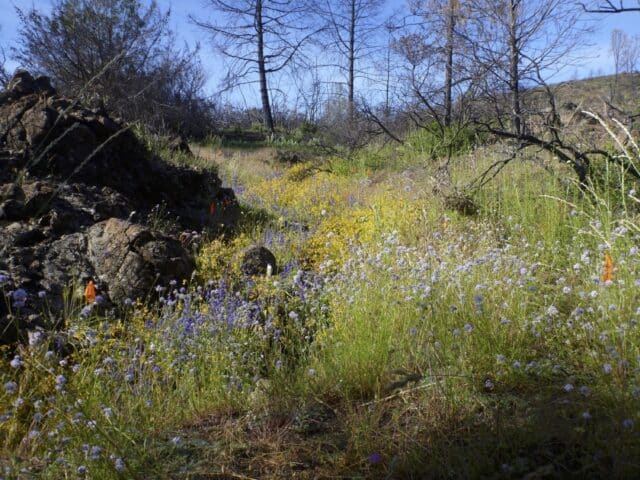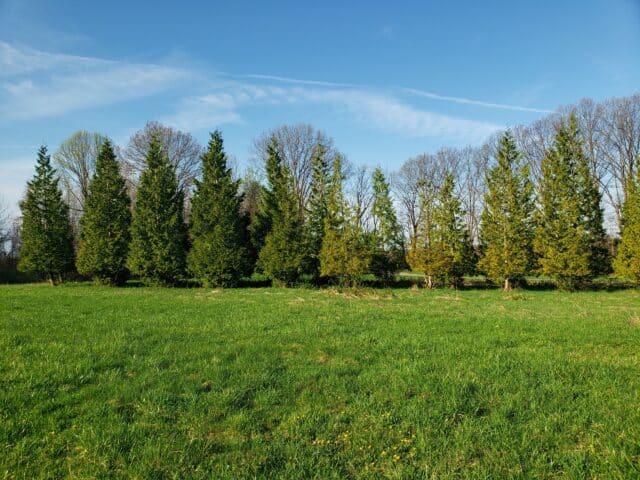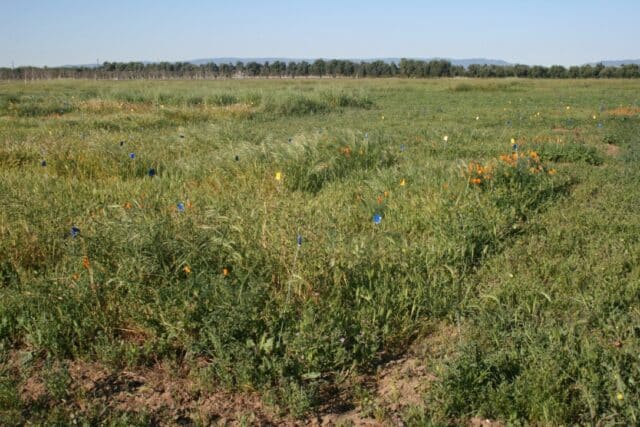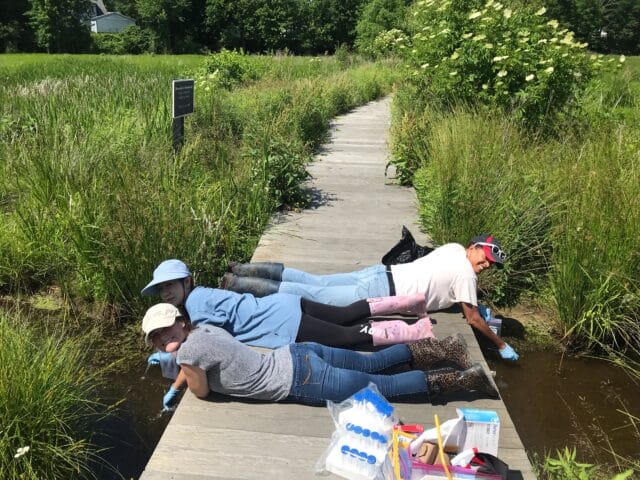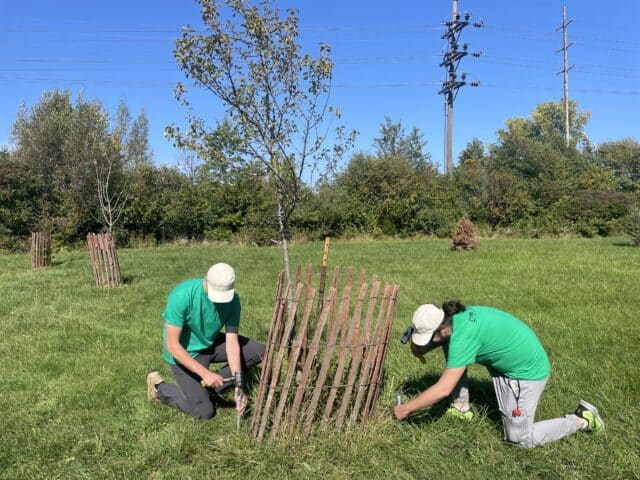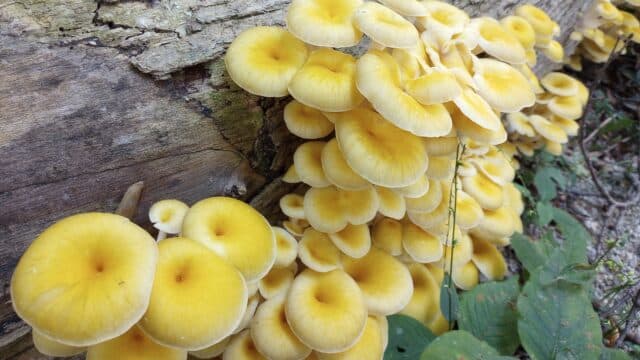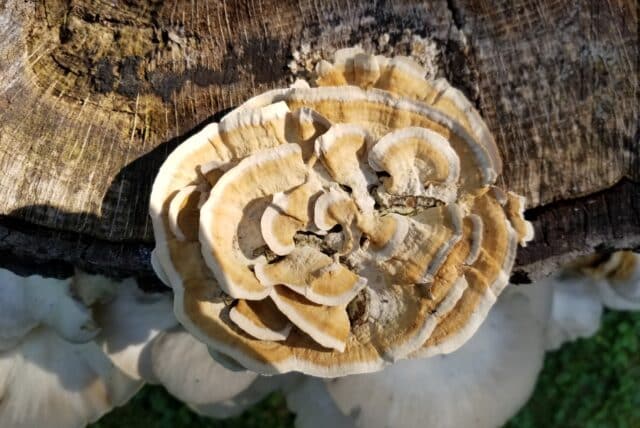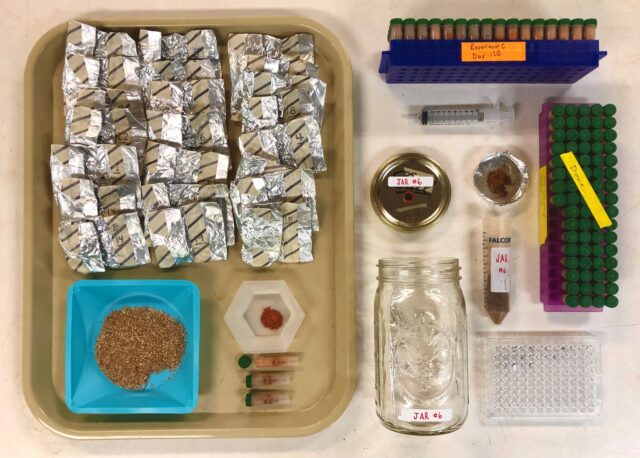
The new Great Lakes Basin Forest Health Collaborative is leading the charge to save ash, beech and hemlock trees. Their base is at the Holden Arboretum.
Wandering the Holden Arboretum, it’s all too easy to take in the trees, stroll the boardwalk and stop to smell the flowers without ever knowing the impact the Holden team is having outside Kirtland. Over in the Ellen Corning Long and T. Dixon Long Center for Plant and Environmental Science, researchers are caring for trees at every stage of life: preparing just-collected seeds to spend a winter in cold storage, watering young seedlings growing in pots in the greenhouse, pruning adult trees in the research orchard and studying trees as they succumb to disease at the end of their lives. Their hope is that these trees — the ones that survive — might hold the key to saving their species.
These American trees are ash, beech and hemlocks. They’re native to the region, are important components of local forest ecosystems and are each under serious threat from their own suite of invasive pests. The emerald ash borer has ravaged populations of ash, American beech is falling ill from beech bark disease and beech leaf disease, while hemlock wooly adelgid (a small aphid-like insect) and elongate hemlock scale are killing eastern hemlock trees across the country.
Experts have been hunting for remedies for each of these pests from the time they were each first spotted, some over a century ago, some within the last decade. But even when something like a pesticide seems to stave off the attackers, the expensive and time-consuming treatments aren’t feasible solutions on any sort of large scale. At some expense, a homeowner can hire a tree care firm to treat the ash tree in their front yard. But that doesn’t help the trees in the forest.
But as these pests swept across the country, people began to notice that even in areas where nearly every tree had been killed, a few stragglers tended to remain. These hold-outs are sometimes called lingering trees. And often, these healthy adult ash, beech and hemlock survived their local infestations because their particular genetic makeup gives them an innate resistance to the pests.
If any trees are naturally resistant, that means those trees can be bred for restoration, opening a new option of replanting and repopulating forests where the trees have been killed. But to pull this off would require a massive effort: to find lingering trees, test them for resistance, breed them and, one day, plant them en masse.
Luckily, many foresters, conservation professionals, scientists and tree lovers have decided it’s worth the effort.
In January 2021, a massive regional endeavor officially launched to breed pest-resistant trees for reforestation. Leaders at Holden Forests & Gardens, the U.S. Forest Service and the non-profit American Forests founded the Great Lakes Basin (GLB) Forest Health Collaborative to lead the way. The Collaborative facilitates collaboration — sharing resources, workloads, research updates and more — between the many organizations across the region working on these forest health efforts.
Partners are already hard at work studying every aspect of these trees, their pests and how natural resistance can be bred into trees on a large enough scale. Experts from other arboretums, the U.S. Forest Service, universities, research institutes, parks, forest preserves and more are joining forces. The hope is that breeding resistant trees for restoration will preserve these important species for the long haul, but that no individual group would be able to pull it off alone. But as a whole, the Collaborative may just be able to save these trees.
—
American Beech (Fagus grandifolia)
A mainstay of eastern forests, our native beech is an American classic. Beech forests burst with bright oranges and yellows in fall, while wildlife go nuts for their beechnuts. Their smooth, gray bark is unmistakable, beneath their glossy, dark, oval-shaped leaves donning zig-zagging branches.
Beech bark disease arrived in Nova Scotia in the 1890s from its native Europe. It’s caused by a bark-eating scale insect that brings fungal infections in its wake. The disease didn’t pop up in the U.S. until the 1930s, and didn’t reach Ohio until the 1980s. In impacted areas, the disease typically kills about half of beech trees within a decade, with around 90 percent expected to die eventually.
But that’s not all that threatens the trees. Beech leaf disease is the newest enemy on the scene, first documented in Ohio in 2012. It’s associated with an infestation by nematodes, a small, worm-like animal that lives in and feeds on buds and leaves. When the disease arrives, the spring leaves emerge as dark, discolored and leathery, with a characteristic striped pattern called interveinal banding.
David Burke, Holden’s Vice President for Science and Conservation, is a leading expert on threats like beech leaf disease. “This is an emerging disease,” Burke explains. “We’re still trying to figure out the biology of this disease, and of course, how to control it.”
Got nematodes? Prune your beech trees! Winter is the best time to prune trees, and if you have a beech, especially one with symptoms of beech leaf disease, pruning can help. Nematodes love wet leaves and branches — they use the water film to move around. Pruning trees will increase light and air circulation, which can dry things out, slowing the spread of the nematodes and the progression of the disease.
“People often ask me, should I just cut all my beech trees down? And our answer is no — some of the trees could be resistant, and those trees are the basis for breeding selection programs,” says Burke. “Don’t take down any trees proactively, even if the ones around them are dying.”
The GLB Forest Health Collaborative has already begun collecting samples from potentially resistant beech trees, and brought them back to Holden for study. “We have about 80 beech trees in our research plantation that are resistant to beech bark disease,” says Burke. “They were selected for resistance to beech bark disease, and I’d say probably about 40 percent of them look really good even though the ones around them have beach leaf disease and are looking really ragged.”
These clones will undergo further testing to see if they’re resistant to beech bark and/or beech leaf disease. If they are, they’ll be used to breed trees that could one day be used for replanting efforts.
Eastern Hemlock (Tsuga canadensis)
Across Appalachia and into the Great Lakes basin, Eastern hemlocks thrive in forests along streams, providing year-round shade and shelter to black bears, porcupines, deer and diverse communities of small mammals and birds. In places like the Great Smoky Mountains, these “redwoods of the East” can grow more than 150 feet tall and live over 500 years.
The trees have been fighting elongate hemlock scale for over a century, ever since the Japanese insect was first found in New York in 1908. The tiny brown insects lie super flat, barely resembling the animals that they are, and feed by sucking the nutrients out of hemlock needles.
Meanwhile, another insect, the hemlock woolly adelgid, is also attacking the trees. First found in the eastern U.S. in Virginia in 1951, these white, fuzzy, aphid-like critters attach themselves to the base of the needles and — like the scale — suck the nutrients out. These two pests are particularly fearsome when they occur together, giving the trees a one-two punch that can render them dead in less than a decade.
Experts estimate that at least half of the hemlock population is infested. In the worst-hit areas, over 80 percent of the trees have died.
Hemlock tree ID: Hemlocks loosely resemble spruce or firs, with short needles spaced along their branches. But hemlock needles are flat (if they’re easily rolled in your fingers, you may have a spruce) and have a little stem that connects each one to the branch (if the needles attach directly to stems, you may have a fir). Hemlock needles are also more rounded than straight, and often have two white racing stripes on the underside. Remember: “Hems have stems!”
One of the first efforts of members of the GLB Forest Health Collaborative has been to facilitate work on figuring out how to best propagate the trees in captivity. Key research partners from the U.S. Forest Service Northern Research Station and the New Jersey Forest Service have been studying how to encourage trees to flower and seed faster.
In the fall of 2021, people across the country started collecting hemlock seeds for research, sharing them with Holden and the National Seed Lab. That winter, forest health coordinator Rachel Kappler and others at Holden prepped the seeds and put them into cold storage for stratification — a process that preserves them while preparing them to germinate as soon as they’re thawed and conditions are right.
And this April, almost 900 hemlock seedlings arrived at Holden from New Jersey. These trees come from a population where hemlock woolly adelgid has been causing problems for 40 years — but these trees seem to be doing fine. They’re up next for testing to see if they’re truly resistant to the pest.
Ash (Fraxinus spp.)
The emerald ash borer was first spotted in the U.S. in 2002, outside Detroit’s shipping yards. It made it to Ohio by February 2003. And since then, the Asia native has spread to 36 states and the District of Columbia, as well as five Canadian provinces.
Underneath a tree’s bark is a layer of tissue that it uses to transport food and nutrients. This is the emerald ash borer’s favorite food. The small, shiny green beetles burrow inside, tunneling around the cambium until they’ve killed the tree.
The National Park Service estimates there are around seven billion ash trees in the country. So far, hundreds of millions have been killed by the borer. In places where it has spread, it’s killed almost 100 percent of the trees — almost. The few that remain will be critical to find, study and, if they’re truly resistant, breed for restoration.
Ash tree ID: Ash trees have three key features that they all share: (1) Opposite stems and leaves. This means that where a leaf attaches to a branch, there’s another leaf directly opposite of it. (2) Compound leaves with 5-9 leaflets. Like hickories, walnuts, locusts and other common trees, ash have leaves made up of smaller leaflets. (3) Gray bark that makes a diamond pattern (especially in mature trees).
Behind the Long Science Center at Holden, there’s an orchard. Each tree is a special ash — a clone made by grafting a branch from a potentially resistant tree in the wild onto a separate sapling (or rootstock) that will serve as the tree’s new base. The trees went in in 2015 — before the Collaborative was even an idea — but the trees have started producing seed of their own this year, just in time to accelerate the Collaborative’s efforts. The GLB Forest Health Collaborative’s partners are working on installing new ash clone orchards in other locations across the region.
In September, the Collaborative sent word to local newspapers across the Great Lakes region that they were on the hunt for lingering ash trees and starting to collect their seeds. Within a few weeks, a half dozen private citizens from Ohio, Illinois and Michigan had heeded the call and had agreed to send seeds to Holden for research.
The GLB Forest Health Collaborative is making steady progress for each of their trees. Many Collaborative partners across the country are chipping away at the unanswered questions about these trees and their pests, while others are already at work breeding resistant trees. But there’s so much left to be done. Here’s how to lend a hand:
- Report lingering trees with the app TreeSnap. Think you’ve spotted a lingering ash, beech, or hemlock? Let researchers know by uploading your observations with the easy-to-use app, TreeSnap. Find it in the app store. Learn more at: https://treesnap.org/
- Volunteer at the Holden Arboretum. There’s work to be done, and you can help! Researchers can use assistance repotting trees in the greenhouse, maintaining orchards behind the science center, collecting data and more. Learn more at: https://holdenfg.org/make-an-impact/volunteer-opportunities/
- Join the GLB Forest Health Collaborative. If you’re in the tree conservation sector in the eastern or central U.S., join the Collaborative! They’re always adding new partners who can help with: monitoring trees, monitoring the spread of insects and disease, locating potentially resistant individuals, collecting and storing seeds and scions, germinating or grafting trees and/or planting trees for research. Contact Forest Health coordinator Rachel Kappler at [email protected] for more info.
